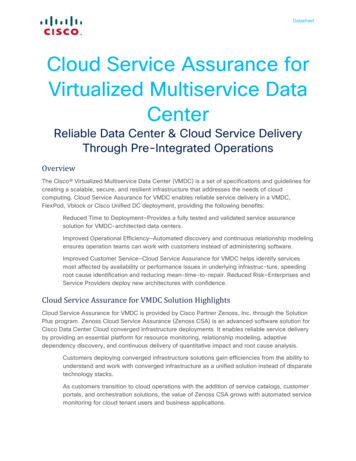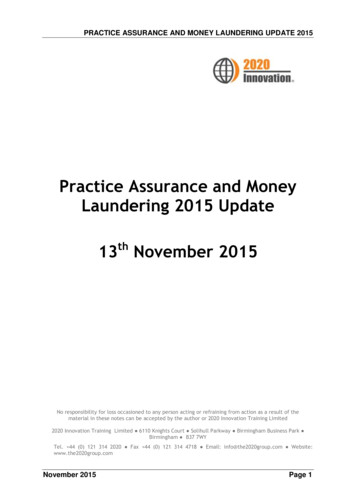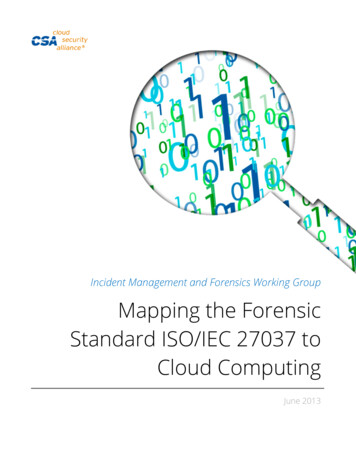
Transcription
DatasheetCloud Service Assurance forVirtualized Multiservice DataCenterReliable Data Center & Cloud Service DeliveryThrough Pre-Integrated OperationsOverviewThe Cisco Virtualized Multiservice Data Center (VMDC) is a set of specifications and guidelines forcreating a scalable, secure, and resilient infrastructure that addresses the needs of cloudcomputing. Cloud Service Assurance for VMDC enables reliable service delivery in a VMDC,FlexPod, Vblock or Cisco Unified DC deployment, providing the following benefits:Reduced Time to Deployment—Provides a fully tested and validated service assurancesolution for VMDC-architected data centers.Improved Operational Efficiency—Automated discovery and continuous relationship modelingensures operation teams can work with customers instead of administering software.Improved Customer Service—Cloud Service Assurance for VMDC helps identify servicesmost affected by availability or performance issues in underlying infrastruc-ture, speedingroot cause identification and reducing mean-time-to-repair. Reduced Risk—Enterprises andService Providers deploy new architectures with confidence.Cloud Service Assurance for VMDC Solution HighlightsCloud Service Assurance for VMDC is provided by Cisco Partner Zenoss, Inc. through the SolutionPlus program. Zenoss Cloud Service Assurance (Zenoss CSA) is an advanced software solution forCisco Data Center Cloud converged infrastructure deployments. It enables reliable service deliveryby providing an essential platform for resource monitoring, relationship modeling, adaptivedependency discovery, and continuous delivery of quantitative impact and root cause analysis.Customers deploying converged infrastructure solutions gain efficiencies from the ability tounderstand and work with converged infrastructure as a unified solution instead of disparatetechnology stacks.As customers transition to cloud operations with the addition of service catalogs, customerportals, and orchestration solutions, the value of Zenoss CSA grows with automated servicemonitoring for cloud tenant users and business applications.
Cloud Service Assurance for Virtualized Multiservice Data CenterCisco and Zenoss have jointly validated the Zenoss Cloud Service Assurance product, extendingand customizing it to work with the VMDC architecture and Cisco Unified Data Center.Figure 1.Zenoss Cloud Service Assurance System ArchitectureCloud Service Assurance for Virtualized Multiservice Data CenterTable 1. Solution HighlightsHighlightDetailsUnified service assurance Single product with out-of-the-box coverage for compute, virtualization,for Cisco Data Centerstorage, and networking devices provides service assurance for cloud tenants,solutions componentsbusiness applications, and converged infrastructure deployments.Validated data centerdesign for enterprise orservice providerscalabilityZenoss Cloud Service Assurance is validated for the VMDC 2.2, 2.3, and 3.0data center architectures.Comprehensive VMDCdevice coverageOut-of-the-box support for compute, virtualization, storage, and networkingservices.Dynamic cloudinfrastructure modelAutomatically discover and maintain identify component devices andrelationships eliminating the need to develop, and maintain, ever changingservice-specific rules.Service impactIdentify service-impacting events across multiple technology stacks, rapidlyawareness and root cause focusing resources on incident root cause. Initial release focusing on compute,analysisthen adding network service impact coverage in upcoming releases.High availabilityHA deployment option provides automated protection against multiple failure
Cloud Service Assurance for Virtualized Multiservice Data CenterHighlightDetailsscenarios.Enhanced SLA reportingProvides tenant-service fault & performance reporting.Automatic discovery withoptional orchestrationintegrationIntegrates with orchestration solutions such as Cisco Intelligent Automation forCloud to provide cloud user-focused service assurance and per-tenant visibilityof resource usage. Automated data center network discovery, Cisco UnifiedComputing, and virtual machines reduces deployment costs. Orchestrationsoftware integration, including Cisco Intelligent Automation for Cloud (CIAC), toautomate service impact.Figure 2.Zenoss Cloud Service Assurance Product Service ImpactZenoss CSA assesses performance and availability failures for each customer, providing reliablyquantified root cause identification.Table 2. Business BenefitsHighlightDramatically improves IT agility,enabling new applications to bedelivered rapidly and providingimmediate awareness of cloudtenant application performanceDetailsDynamically and automatically tracks relationships acrosstechnology stacks to ensure continuous dependency awareness.Immediate real time monitoring of newly provisioned cloudservices with orchestration integration.Fully integrated with hardware managers (UCS Manager) andVirtualization Managers (VMware vCenter) to automatically adaptto additional compute, virtualization, and storage resources.
Cloud Service Assurance for Virtualized Multiservice Data CenterHighlightDetailsConnect IT operations to thebusiness with service awarenessProvides IT awareness of the service health of business services andcloud tenants.Service dependency tracking to identify which tenant services areaffected by an infrastructure outage and whether the outage hasdegraded the service or caused it to fail.Continuous analysis of service-impacting availability and performanceevents quantifies root cause probability and enables quick issuecorrection.Deliver higher customer serviceavailability(SLAs) and performance withimproved MeanTime to Repair (MTTR)Tracks service-specific availability and performance status, enablinginfrastructure engineers to focus on customer issue resolution.Provides root cause analysis combining multiple technology stacks,enabling faster and more accurate incident assignment. Initial releasefocusing on compute and then adding network service impactcoverage in upcoming releases. Extensible integration withorchestration permits automation of routine recovery tasks.Supports and tracks success of cloud-specific recovery operationssuch as vMotion.Increase return on IT investmentRealize the full benefit of converged infrastructure by increasingeconomies of scale.Increase overall asset utilization without affecting performance byidentifying areas of high and low resource utilization.Increase server-to-staff ratio by implementing replicable, automatedprocesses.Keeps IT in control throughstandards and policiesMonitoring-by-policy, so that newly provisioned workloads receiveconsistent implementation of best-practice monitoring and policycompliant impact service management and root cause analysis.Maintain continuous awareness across the dynamically-changingenvironment.Table 3. IT BenefitsHighlightDetailsComplete coverage forCisco VMDC infrastructureOut-of-the-box monitoring policies for Cisco UCS compute, VMware vCentervirtualization, Nexus networking, and NetApp and EMC storage resources.Supports FlexPod and vBlock solutions.Automated discoveryChange-driven and scheduled discovery ensures accurate understanding ofcloud infrastructure.Accurate relationship modelMaintains an up-to-date model of the relationships between compute,virtualization, storage, and networking components using context provided bycomponent configuration.Event, availability, andperformance managementSingle pane of glass eliminates the need to integrate separate managementapplications.
Cloud Service Assurance for Virtualized Multiservice Data CenterHighlightDetailsCloud scalabilityDistributed architecture supports deployment models from proof of concept tomulti-data center production operations.Customizable, extensible,integrate-ableExtensive set of APIs.Automated configurationdiscoveryChange-driven and scheduled configuration discovery ensures accurateunderstanding of the cloud infrastructure.Accurate relationship modelMaintains an up-to-date model of the relationships between compute,virtualization, storage, and networking components using context provided bycomponent configuration.Relationship visualizationAdministrators can see the current relationships between compute,virtualization, storage, and networking components to better understandissues and potential issues.Automatic creation andmaintenance of tenant andbusiness application enduser servicesService definition is created and modified concurrently when the Cloud Portalis used to create or modify services and cloud resources are provisioned.Continuous understandingof service dependenciesTracks and maps the compute, virtualization, network, and storage resourcesused by each end user service into a service dependency model. The model isdynamically and automatically maintained with changes to cloud infrastructure.Service Impact identification When infrastructure availability and performance events occur, Zenoss CSAand quantitative root cause identifies affected end user services using the relationship model. The serviceanalysisdependency model is analyzed to determine impact level. A continuousquantitative root cause analysis process suppresses event floods andidentifies potential impact chains in order of probability.Zenoss CSA provides out-of-the-box service impact support for Windowsand Linux workloads, VMware vSphere, Cisco UCS, NetApp filers, EMCstorage arrays, and a limited set of network components. Service impactsupport can be extended to provide additional coverage.Event flood suppressionWhen multiple technology stacks are combined in a private cloud, singleincidents generate a flood of sympathetic events. Zenoss crosses technologyboundaries to provide a quantitative ranking of potential points.Cloud Service Assurance Use Case CoverageZenoss Cloud Service Assurance supports the following CSA scenarios.
Cloud Service Assurance for Virtualized Multiservice Data CenterTable 4. Cloud Service Assurance SupportScenarioZenoss CSA FunctionUnified monitoring datacollection platform forVMDC componentsCollects fault, availability and performance data from all VMDC components.Generates availability and performance data using synthetic transactions.Supports physical, virtual, and cloud devices Supports multiple data collectionprotocols.Multiple data collectionprotocols and APIsSNMP, Syslog, XMLRPC, JSON/API, AMQP, SSH, JMX, WMI, Windows Perfmon,SMI-S, ICMP, Telnet, UCSM XML API, NetConf, vSphere SOAP API, vCloudDirector, Amazon EC2 CloudWatch, Cisco CallManager AXL, HTTP, ODBC,SMTP, POP, DNS, LDAP, NTP, FTP, IRC, XMPP, RPC, NNTP.Extensible with scripting.Agent-less data collection Leverages native agents (no need for installing extra agents).Resilient, distributeddeploymentScales horizontally to support very large environments.Supports proof-of-concept and small environments with a single virtualmachine.High availability configuration enables operation with no single point of failure.Automated discovery ofVMDC network andnetwork service devicesWithin an IP address range, discovers and identifies supported VMDCnetworking devices.Classifies devices, applies device-specific monitoring templates, and beginsdata collection.Collects fault events and performance KPIs.Tracks configuration changes such as establishment of new network services.Advanced coverage for Nexus 1000v and VSG, 2000, 3000, 5000, and 7000series; Catalyst 6500 and VSS with FWSM, ASA, and ACE modules, ASA 5500,ASR 1000 and 9000, and MDS 9000 devices.Automated discovery ofCisco UCS componentsUses Cisco UCS XML API to automatically track newly added components in aUCS complex. Tracks assignment of service profiles to blades.Uses UCS-specific monitoring templates to collect fault events, configurationchanges, and performance KPIs.Tracks association between service profiles and the operating system running onthe blade, providing automatic impact relationship management.Automated discovery ofVMware guestsUses VMware vSphere API to automatically discover and track changes to virtualmachines, hosts, datastores, clusters, and resource pools.Uses VMware-specific monitoring templates to collect fault and task events,relationship changes such as vMotion events, and performance KPIs.Tracks association between virtual machines and operating systems, ESX/ESXihosts and UCS service profiles, datastores and NetApp LUNs, providingautomatic impact relationship management.Monitoring of NetApp FAS Uses NetApp APIs to automatically discover and track changes to LUNs, filefilerssystems, Qtrees, etc. Uses NetApp-specific monitoring templates to collect faultand task events and performance KPIs.
Cloud Service Assurance for Virtualized Multiservice Data CenterScenarioZenoss CSA FunctionTracks association between LUNs,filesystems, and VMware datastores,providing automatic impact relationship management.Monitoring of EMC VNXand VMAX storagesystemsConnects to EMC SMI-S Provider to automatically discover and track changes tostorage pools, hard disks, arrays, enclosures, link control cards, power supplies,batteries, storage processors, and storage processor ports.Supports block mode devices with EMC-specific monitoring templates forperformance KPIs and fault events.Monitoring of Windowsand Linux workloadsUses multiple operating system-provided APIs to automatically discover andtrack changes within each operating system, such as additional file systems ornew Windows services.Uses operating-specific monitoring templates to collect system events andperformance KPIs and verify availability of device and components.Tracks association between operating system and virtual machine or operatingsystem and UCS service profile, providing automatic impact relationshipmanagement.Consolidated visibility forevents, availability, andKPIsWeb console provides single user interface with access to monitoring data for allVMDC components.Consistent device model crosses VMDC technology stacks to common datapresentation for infrastructure engineers.Identifies error conditions Generates events when performance KPIs are outside of desired range. Applieswith threshold analysis of Holt-Winters algorithm to provide predictive thresholds.performance KPIsScenarioZenoss CSA FunctionStores events and performance Performance KPIs are stored by default for 90 days.KPIs for historical reportingEvents are stored by default for up to one year.Defaults can be modified to meet individual needs.Provides event managementfacilitiesIdentifies and suppresses duplicate events by incrementing event countand updating most recent event date and time.Identifies and suppresses non-critical events from the event console andoptionally from the event database.Recognizes “clear” events indicating a fault condition has improved andautomatically closes the original fault event. Automatic event enrichmentadds affected business applications and tenant services to relevanteventsEnables event enrichment by levering knowledge of componentsand relationships.Integrated action andnotification frameworkOut-of-the-box actions library.Open and extensible.Escalation and calendaring support.Maintenance window support.
Cloud Service Assurance for Virtualized Multiservice Data CenterScenarioZenoss CSA FunctionSimplified iIntegration withOSS/BSS existing managementsystems and processesAbstracted and normalized integration interface for all VMDC devices usinga single northbound API delivers select events for all convergedinfrastructure devices as well as business applications and tenant services.API provides for device event integration using any combination of SNMPtraps, Email, JSON API, Page, AMQP, and scripted integration such ascalls to REST interfaces.Integration with BMC Remedy and Service Now ticketing systems isprovided.Unlimited number of northbound destinations.Integration withOrchestration/ServiceFulfillmentPublished interfaces for device discovery and classification, impact servicecreation, management, and policy creation. Data extraction interfaces forbusiness application and tenant service status, KPIs, and events. TenantService Impact integration with CIAC is available.Orchestration vendor- independent implementation.Tenant service and VM association can be loaded to Zenoss CSA withoutan automated orchestration system.Open and extensibleJSON API provides access to device model and attributes, performancedata, event data, and service data. JSON API can also be used to manageevents (acknowledge, clear, close), add and remove monitored devices,set production/maintenance state for devices, initiate discovery andmodeling, manage thresholds, and more.Automatic discovery of tenantbased service impact modelService impact model for compute maps tenant VMs to s dedicated andshared vCenter and UCS managed resources.Tenant root causePrioritized events by business relevance and urgency.Identifies service impacting technical risk, enabling future failures to beaddressed prior to tenant impact.Visual confirmation of whether redundancy is protecting serviceavailability.Root cause analysisClassifies events as probable root cause vs. symptomatic events.Combines event correlation rules with service topology models.Impact analysisDynamically maintains a graph of relationships between physical andvirtual resources.Propagates fault and performance degradation through graph to inferbusiness service impact and probable root causes. Reduces event consoleto a few root causes.Service impactFocus on service state vs. resource state. Notify only on change in servicestate.Provides root cause analysis focused on individual services.
Cloud Service Assurance for Virtualized Multiservice Data CenterZenoss Cloud Service Assurance Converged Infrastructure SupportComputeCisco UCS, including Fabric Interconnect,Chassis, and B-series blade servers.VirtualizationVMware vSphere.StorageNetApp FAS series, EMC VNX, EMC VMAX.NetworkNexus 1010, 1000v and VSG, 2000, 3000, 5000,and 7000 series; Catalyst 6500 andVSS with FWSM, ASA, and ACE modules, ASA5500, ASR 1000 and 9000, and MDS 9000.Workload OSWindows, Linux.Workload applicationsMicrosoft Active Directory, Microsoft Exchange,Microsoft Internet Information Server, MicrosoftSQL Server, Apache Tomcat, BEA Weblogic,JBoss Application Server.ExtensibilityAdditional capabilities available from partnerZenoss.Zenoss Cloud Service Assurance ScaleTotal Number of Monitored Components1,500,000 with 5 KPIs per componentContinuous Event Rate5,000 events per secondFor More InformationTo learn more about Cloud Service Assurance for VMDC, download the Cisco Validated DesignGuide from www.cisco.com/go/cloudassuranceCisco Design ZoneDesign Zone for Virtualized Multi-Services Data Center (VMDC)
Reliable Data Center & Cloud Service Delivery Through Pre-Integrated Operations Overview The Cisco Virtualized Multiservice Data Center (VMDC) is a set of specifications and guidelines for . Relationship visualization Administrators can see the current relationships between compute, virtualization, storage, and networking components to .










